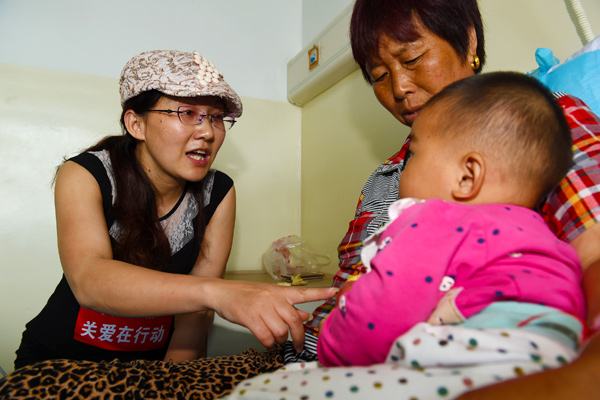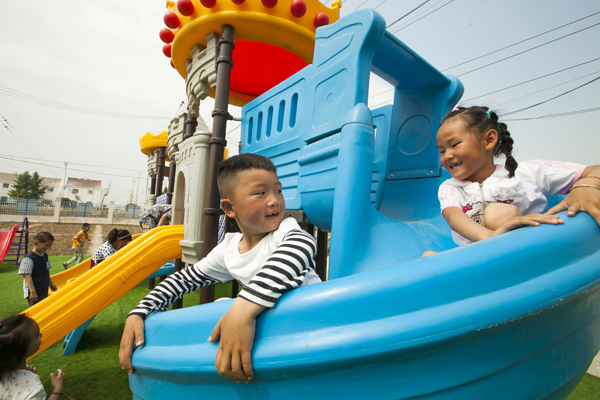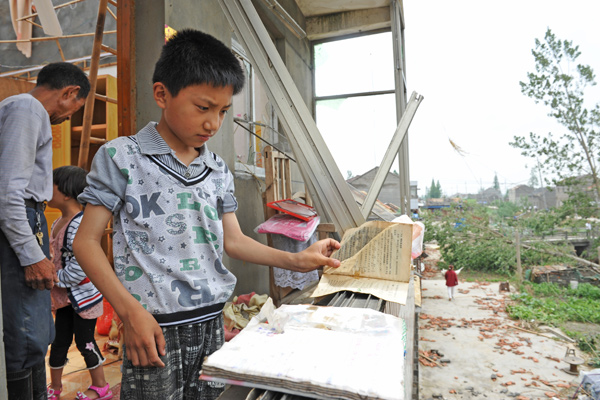
Villagers come together to rebuild lives
Luo Wangshu
A year ago, a small county in East China was devastated by a tornado that destroyed lives and homes. Now, the local people are determined to forge a new future.
Villagers come together to rebuild lives
When a tornado struck Li Yuhong's kindergarten, the school head had no time to be scared.
"It all happened too quickly, in the blink of an eye. The children had just woken from their early afternoon naps, and the older children were using their coloring books, when, all of the sudden, the weather changed. In just a few moments, dark clouds spread across the sky as if it were night. The children and I had never seen such a thing before. They cried because they were scared," Li recalled, speaking almost a year after the disaster.
At 2:30 pm on June 23 last year, a tornado hit Funing and Sheyang, two densely populated suburbs of Yancheng, a city in the eastern province of Jiangsu, about 300 kilometers from Shanghai.
The twister left 99 people dead, and 875 hospitalized. More than 31,800 homes were destroyed, and the lives of 45,500 residents were shattered. The direct economic loss was about 5 billion yuan ($730 million), according to Wang Rongping, Yancheng's Party chief.

In the village of Shuangqiao in Funing, farms and factories were razed, and roofs were torn off countless buildings, including some at Li's school, the Nanwan Kindergarten.
"The classroom, desks and even the floor were shaking, so I told the students to lie under their desks in a prone position. One girl stood up and attempted to run to me-she was crying and shouting for her grandmother-but she couldn't even stand properly. Then, the roof of the building next door collapsed and tiles and bricks flew toward the back windows of the classroom. As I grabbed the girl and took her into my arms, a shard of glass sliced into my nose. The whole class was crying. I told the children to crawl towards me. We held hands and put our arms around each other," Li said, tearfully, trembling at the memory.
"We were so lucky. Sometimes, I can't stop wondering what would have happened if we had been on the playground-all the children would have been blown away. What if I had died in the tornado, like the mother of one of my students? The first anniversary of my death would be approaching," she said.
Time to heal
It takes time for adults to overcome the trauma caused by the tornado, but it's even harder for vulnerable children to put such a disaster behind them.
"It takes time, sometimes 2 to 3 years, for children to get through the shadow of a tragedy," said Yang Zhaobao, head of the Sunshine Psychological Health Center, a counseling facility in Funing.

"The healing process varies according to the individual. For most of the children, the stress responses will disappear in a year, but some bad memories may lurk and resurface later if a random incident triggers a response," he said.
Counseling professionals are still helping the children to cope with the trauma.
In the wake of the disaster, professional organizations, including local mental health clinics, universities and research institutes, and charity groups set up both temporary and long-term centers in the county.
Three days after the tornado, a picture book center was established in a tent.
"We accompanied the children and helped them release the pressure and negative emotions by telling stories, playing games and painting," Yang said.
"Many of the children were distraught and reluctant to communicate. Our center received Dabao and Xiaobao, 4-year-old twin brothers; when they first came to the center, they hid behind their grandparents and refused to come out. But later, when they saw our volunteer teachers, the twins ran to them and asked to play games," he added.
"Many children chose to paint pictures in black and other dark colors, drawing dark clouds with short, staccato lines, indicating anxiety and tension. After our intervention, their paintings became brighter and more colorful with steady lines, meaning their psychological state had improved."
There is no official data about the number of children who received psychological counseling, but the picture book center received 30 children a day for two months.
The Institute of Psychology at the Chinese Academy of Sciences set up two recovery centers, one in a school and the other in the community, to help the children recover.
"Tornadoes traumatize children, so our first job is to calm their emotions and tell them it's normal to be frightened and to cry, and it's OK to feel helpless. We let the children release stress. For example, they cried when more bad weather came, and their parents usually told them not to be scared. But we told them, 'If you want to cry, then cry'. We allowed them to release their negative emotions, such as fear and anxiety," said Sun Rui, a licensed psychological counselor with the institute who volunteered to work in Yancheng, to explain the recovery process.
Along with her colleagues, Sun also provided safety education.

"The children didn't know what to do when the disaster struck, so they panicked. We have taught them to protect themselves, such as how to react during such a disaster, where to hide, and the safe use of electricity and water," she said.
Having arrived in Yancheng to set up the center, Sun has stayed for a year, but she will finish her work and leave Yancheng at the end of the month. Instead, a weekly regular psychological health class will be available at the Nanwan Kindergarten.
"We evaluate the disaster and the state of people's mental health, and then formulate an action plan. In Yancheng, the program has lasted a year," she said.
Greater awareness
Guided by the professionals, the local teachers have gained greater awareness and the skills to provide counseling. Li, the school head, uses a small sandbox and toy figures to assess the children's mental state; if the child buries the figures deep in the sand, it may indicate that they are repressing emotions and memories.
To further alleviate their anxiety, she teaches her students about the causes of tornadoes, and practices safety drills with them.
"A tornado is a strong kind of weather that mostly comes with pouring rain," she explained to a class of 5-year-old students.
To demonstrate, she inflated a balloon and held it tight to prevent the air from escaping. Then she asked a student to come forward, and released her grip on the balloon so the student could feel the air being released.
"This is wind-it's not scary," she said, and offered another example with a bicycle pump.
She had drawn a picture of a tornado on the blackboard. "It is important for the students to understand that tornadoes don't just happen when they are at school, and we also tell them it's natural to be frightened," she said.
"We've held many safety seminars for the children. We tell them the tornado won't come again, but even if it does it won't affect them."
After the tornado, the kindergarten's buildings were wrecked, and trees were strewn across the playground. However, after two months of reconstruction work, the kindergarten reopened on August 30.
Li experienced a combination of ecstasy and anxiety.
"On the first day, the little girl I saved arrived with her grandma. She dashed across the playground and ran toward to me, but she was still very nervous at school. When her grandma took her to use the bathroom, she cried and would not let go of her. She insisted the elderly lady went into the cubicle with her. Some other children refused to leave their parents, and screamed: 'This is a bad kindergarten. This is the kindergarten that was struck by a tornado'," she recalled.
"What if no one wants to come to kindergarten again?" she said, with concern in her voice.
As the anniversary of the disaster approached, Li had a chance to review her difficult year: "It was the darkest moment of my life. But I will endure this hardship with my students. It's time to heal the wounds and not allow this event to affect our lives."
Meghan Horihan contributed to this story
Contact the writer at luo-wangshu@chinadaily.com.cn